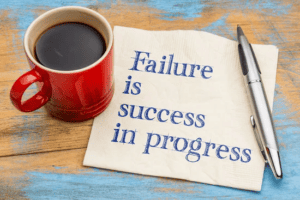
Embrace Failures
Embrace Failure as a Natural Part of the Learning Process and Use It to Grow and Improve. Failure is a
Embrace Failure as a Natural Part of the Learning Process and Use It to Grow and Improve.
Failure is a natural part of the learning process. Whether it’s a small setback or a major disappointment, failure can be difficult to handle. However, it’s important to remember that failure can also be a powerful teacher. By embracing failure and using it to grow and improve, we can turn our mistakes into opportunities for learning and development. One of the biggest obstacles to embracing failure is fear. Fear of failure can be paralyzing, causing us to avoid risks and stay within our comfort zones. However, staying within our comfort zones can prevent us from reaching our full potential. When we avoid failure at all costs, we also avoid opportunities for growth and development.
To embrace failure, we must first reframe our mindset. Instead of viewing failure as a negative outcome, we should view it as a necessary step on the path to success. When we make mistakes or encounter setbacks, we can use those experiences to learn and improve. By seeing failure as a natural part of the learning process, we can become more resilient and better equipped to handle challenges. Another way to embrace failure is to adopt a growth mindset. A growth mindset is the belief that our abilities can be developed through hard work and dedication. With a growth mindset, we view failure not as a reflection of our innate abilities, but as an opportunity to learn and improve. When we approach failure with a growth mindset, we can focus on the lessons we can learn and the skills we can develop, rather than the negative feelings of disappointment or shame.
To effectively embrace failure, we must also practice self-compassion. Self-compassion is the act of treating ourselves with the same kindness and understanding that we would offer to a friend. When we experience failure, it’s easy to be self-critical and harsh. However, self-criticism can be counterproductive, leading to feelings of shame and self-doubt. By practicing self-compassion, we can acknowledge our mistakes without judging ourselves harshly. This can help us bounce back from failure more quickly and effectively. When we embrace failure as a natural part of the learning process, we can use it to grow and improve in several ways. First, failure can help us identify areas where we need to improve. When we encounter a setback, we can ask ourselves what went wrong and what we could do differently next time. This can help us develop a deeper understanding of our strengths and weaknesses and create a plan to improve. Second, failure can help us build resilience. When we encounter setbacks and obstacles, we can choose to give up or keep going. When we choose to keep going, we build resilience and perseverance. Over time, this can help us develop the mental toughness needed to overcome challenges and achieve our goals.
Finally, failure can help us become more creative and innovative. When we encounter a setback, we can approach the problem from a new angle or try a different solution. This can help us develop new skills and ideas that we may not have considered otherwise. Failure is a natural part of the learning process. When we embrace failure and use it to grow and improve, we can turn our mistakes into opportunities for learning and development. By reframing our mindset, adopting a growth mindset, practicing self-compassion, and focusing on the lessons we can learn, we can become more resilient, creative, and effective in achieving our goals. So, the next time you encounter a setback, embrace it as an opportunity to learn and grow, and use it to become a better version of yourself.

Embrace Failure as a Natural Part of the Learning Process and Use It to Grow and Improve. Failure is a

If you’re struggling with multiple debts and high interest rates, debt consolidation can be a helpful strategy for getting out

Owning a home is a dream for many people, but it can also be a daunting prospect. The process of
Copyright © AVN foundation 2021. All rights reserved. Developed by AVN Foundation